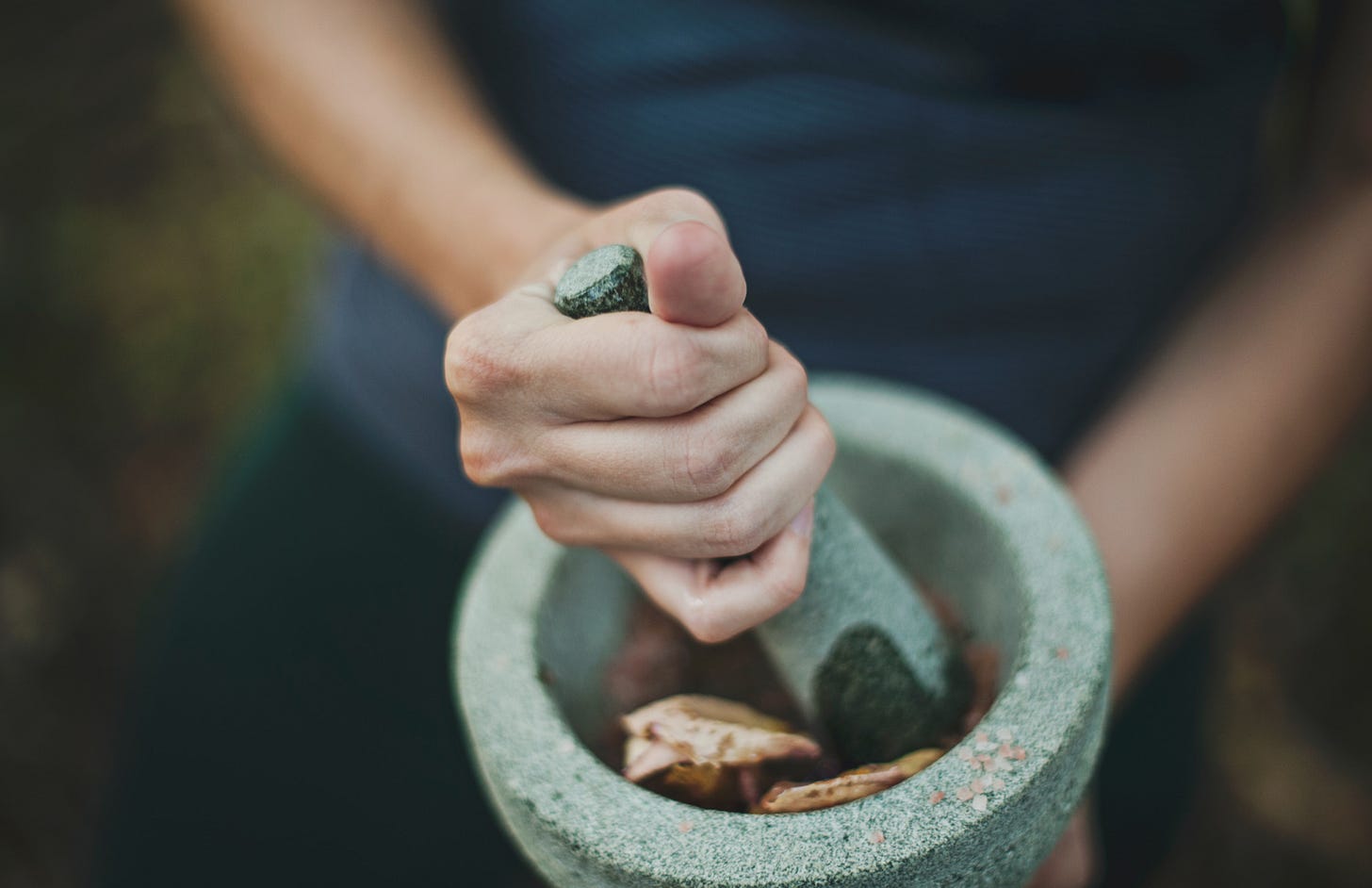Leave These Herbs Out of the Kitchen
Keep your practice safe and productive with herbal knowledge.
Hello, wonderful witches!
I’m writing you from a cabin in the woods in Ohio, where my partner and I have decided to social distance for the week. Do you remember the orchard owner who says spells to his apples? We’re heading to that orchard in the next day or so, with a fistful of cash to bring back enchanted fruit. The internet here is pretty spotty, so all you free subscribers, it’s your lucky day: You’re getting today’s issue in full as a bonus. We’ll be back to our regular schedule next week of a full free issue the first Thursday of every month, and full issues for paid subscribers only every week otherwise.
Today, we’re taking a don’t-try-this-at-home theme. First, we’re checking in with writer and herbalist Claire James Carroll, who shares some herbs that require some extra care in the kitchen—or else they might kill you. We’ll also hear from writer Rachel Friedman with a recipe used during the witch trials to find malevolent witches.
You'll Rue the Day! Magical Herbs to Keep OUT of the Kitchen
By Claire James Carroll

Preparing ingredients in a mortar and pestle. Photo by Katherine Hanlon on Unsplash.
Herbs have power—which is why they’re so prominent in magic—but they’re not always positive. Some magical herbs like belladonna or jimsonweed are renowned for their lethal properties, which is part of their magical appeal. However, practitioners must be careful when working with baneful herbs to avoid hurting themselves and others.
As the science surrounding herbal interactions advances, witches have a responsibility to confirm that their traditional spells do no accidental harm. Here are four dangerous magical herbs (and less toxic alternatives) depending on the type of spell you’re looking to cast.
Comfrey (Symphytum officinale)
Also known as “knit bone,” comfrey has a long curative history of treating bruises, bone damage, and arthritis. It’s used magically for healing and good fortune while traveling or gambling. However, recent research suggests that, when ingested, comfrey damages the liver and acts as a carcinogen. As safer alternatives, nutmeg can be used in luck and gambling spells while coriander can aid healing and prosperity.
Rue (Ruta graveolens)
Painters and witches have eaten rue for centuries to improve their sight. It is traditionally used in protective spells and for promoting second sight. However, the plant acts as a carcinogen and can cause severe kidney damage. It also has abortifacient properties, making it especially dangerous to anyone who is pregnant or may become pregnant. Alternatives to rue include nettles, if you’re looking for another Mars-aligned protective herb, or eyebright for second sight strengthening.
Mandrake (Mandragora officinarum)
The mandrake root’s resemblance to the human body explains its uses in protection and fertility spells. However, mandrake has similar chemical properties to belladonna and acts as a powerful narcotic. In small quantities, mandrake induces hallucinations, but it can be lethal in larger doses. Rosemary is a kitchen-friendly alternative for the major mandrake uses.
Wolfsbane (Aconitum napellus)
Wolfsbane is a shapeshifting plant loaded with werewolf lore. It is used to both combat and promote shapeshifting, but is one of the most lethal baneful herbs. If you do work with wolfsbane, always wear gloves as the toxic alkaloids can be absorbed through the skin. For this reason, many witches who use wolfsbane cast near a growing plant without touching it. Dragon’s blood resin can act as a substitute for wolfsbane in shape-shifting magic, with beneficial biological interactions.
Working with powerful herbs is a serious responsibility that no practitioner should take lightly. Research the plants you’ll be working with and see if there are clinical studies documenting the biological effects of your spell plants. Take special care to understand the herbal sensitivities of the witches working with you. Even common herbs like chamomile can hurt those with certain allergies.
For safe and intentional casting, ensure that you take the proper precautions. Consider substituting less-toxic plants when possible and practicing safe disposal. Wiccan author Silver RavenWolf recommends destroying any leftover spell materials that contain poisonous plants to lower the risks.
Teas and tinctures can be powerful elements in magical practice, but responsible witches cultivate herbal knowledge in order to understand the divisions between the digestible and the purely magical. Some days, even a kitchen witch must separate their magic from their margaritas.
Claire James Carroll is a writer and herbalist living in the Hudson Valley. She studied writing and archival magic at Yale University and has apprenticed with herbalists throughout New York. Follow her on Twitter at @ClaireJCarroll.
Finding Witches with Cake
By Rachel Friedman

A black-and-white portion from the painting “Witch Hill (The Salem Martyr).” Object Number 1939.251 in the Luce Center of the New-York Historical Society Museum and Library.
This recipe was used at the beginning of the Salem Witch Trials. Unbeknownst to Reverend Samuel Parris, the Puritan minister of Salem Village and the father and uncle of the first of the afflicted girls, two of his slaves took a congregant’s advice to use this recipe and see if the girls were indeed bewitched. This practice was already known in New England in the late 17th century.
*Bear in mind that this is a recipe for finding a malevolent witch.
Materials Needed:
One potential victim of witchcraft. Telltale signs of magical torment may vary. Some classic symptoms are the victim’s testimony that they have seen the devil or a witch’s familiar, or have been tormented by a spectral witch. Victims may writhe about on the floor in apparent unnatural agony.
Rye meal
One dog, preferably a stray
Directions:
Ask the potential victim of witchcraft to give a certain quantity of their own urine. Keep the urine in a watertight container.
Gather rye meal and mix it with the urine to form a cake. Bake the cake in the ashes of any cooking fire.
Feed the cake to the dog. Watch the dog closely to see if they now exhibit the same symptoms of affliction as the person who donated the urine for the cake. If the dog displays the same symptoms, then the donor of the urine is indeed bewitched.
References:
Boyer, P. & Nissenbaum, S. (1974). Salem Possessed: The Social Origins of Witchcraft. Harvard University Press.
Starkey, M.L. (1949). The Devil in Massachusetts. Time Reading Program.
Rachel Friedman majored in history in college, where she developed a particular interest in weird history, including the history of witchcraft. She lives in Southern California with her family.
Have you connected with us on social? We’re filling up Facebook, Instagram, and Twitter with Kitchen-Witch-themed posts and shares. Come join us!
Coming Up Next Week…
Next week, we’re heading to Ecuador to discover a traditional bread and soup combo enjoyed near the end of October. And since Samhain falls on a full moon, you’ll get a recipe for a cocktail to celebrate with.
See you then!



